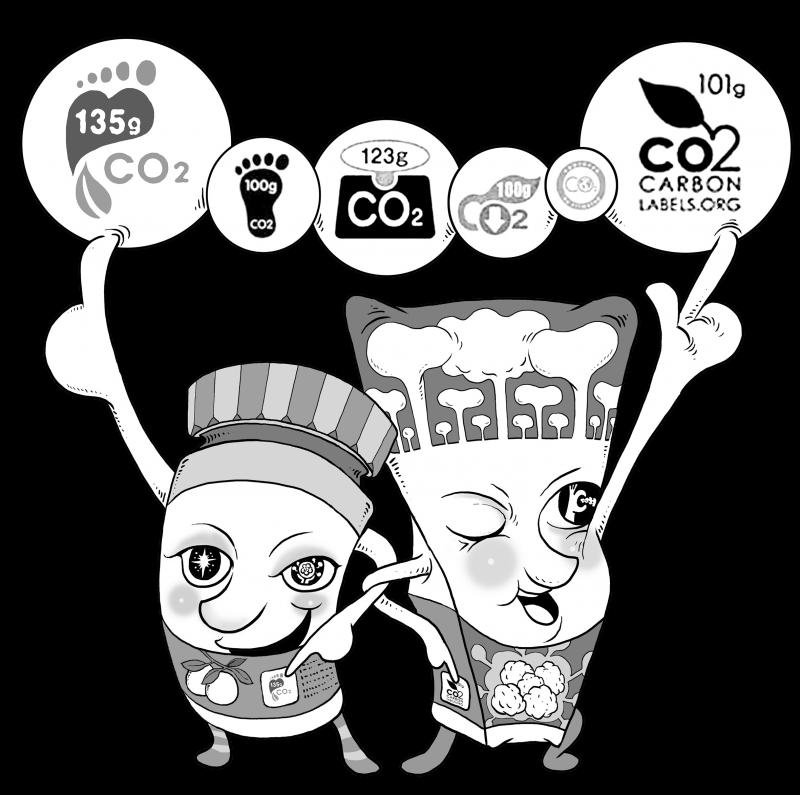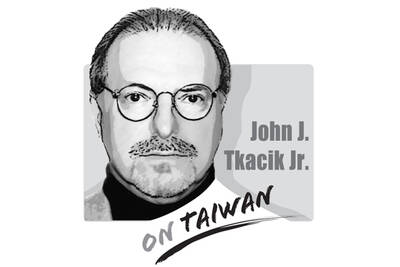Nutritional breakdowns, ethical trade branding, recycling information — and now estimates of a product’s climate impact.
Consumers across the globe are starting to see a new kind of information on goods packaging, indicating the level of planet-heating gases emitted by making the items they are buying.
This fresh wave of efforts at “carbon footprint” labeling is being praised by some as empowering consumers to help tackle climate change, but criticized by others as confusing at best, and “greenwashing” at worst.

Illustration: Mountain People
Danielle Nierenberg, cofounder of Food Tank, a US-based think tank, said a carbon-labeling system has “been in the works for a while,” but companies needed time to research it properly, “so we’re just seeing it now.”
Numi Organic Tea, a California-based company that sources 130 ingredients from 26 nations, is to start putting carbon labels on its teas this summer, after tracking their emissions since 2015.
Figuring out the teas’ carbon footprint required studying farm management practices, processing equipment, energy use along the supply chain and more, Numi vice president for strategic sourcing and sustainability Jane Franch said.
“That was the first step in our journey — wrapping our minds around what is the impact, and looking for places where we can reduce [it],” she said.
The effort has included pushing tea factories to start using cleaner energy and more energy-efficient equipment, she added.
Numi packaging is to carry a label which includes a single, product-specific number: a kilogram of carbon dioxide equivalent, broken down by ingredients, transport, packaging and even the energy required to boil water at a drinker’s home.
“Now is the time — consumers are interested,” Franch said. “Even if they don’t know what a gram of carbon is, it begins to develop the carbon literacy in our consumers and in society writ large.”
Numi joins a growing group of companies that have begun carbon labeling, particularly in the US and Europe — from brands including plant-based-meat producer Quorn to electronics maker Logitech and household goods giant Unilever.
There are also broader efforts, such as a global push announced in February for the cosmetics industry, which includes Estee Lauder Companies, Johnson & Johnson Consumer Health, L’Oreal Group and 33 others.
Some even want a system that is obligatory for all.
“Publishing the climate impact of food products should be mandatory and standardized, just as with nutrition labels,” said a spokesperson for Swedish oat milks producer Oatly, which is leading a petition to the German government on the issue.
Denmark and France are already looking at creating their own consumer carbon labels, while the EU is aiming to come up with a draft for a broader eco-label by 2024.
The food and beverage industry is at the center of the push for carbon labeling, given its outsize climate impact.
The global food system accounts for about one-third of carbon emissions, according to the UN Food and Agriculture Organization, but until recently, most efforts to reduce food-related emissions focused on production, said Edwina Hughes, head of the Cool Food Pledge at the World Resources Institute (WRI).
“We’ve made loads of progress in the last 50 years, but we haven’t looked at consumption as much. That’s pretty significant — if you don’t look at shifting diets, you won’t get where you need to” in terms of curbing climate change, Hughes said.
Some simple interventions appear to offer great potential.
For instance, adding messages at the top of menus nearly doubled the proportion of diners choosing plant-based dishes, WRI research published in February showed.
The Cool Food Pledge program runs a carbon labeling initiative that includes a “badge” on menu items, indicating that they meet nutritional standards and have a smaller carbon footprint than researchers say is needed to achieve key climate goals.
Panera Bread, which has 2,100 North American locations focusing on business lunches, was the first restaurant chain to adopt the badge, in 2020.
The company had measured its carbon footprint since 2016, but that information was not reaching consumers, Panera vice president of food beliefs and sustainability Sara Burnett said.
“We know there are two sides to this coin — what we choose to put on the menu, how we source, but the flip side is consumers. They really impact our business significantly by what they choose,” she said.
About half of Panera’s online menu options carry the badge, with a goal of raising that to 60 percent by 2025, including by working with supply chain vendors and developing new products.
“This is no longer something that is just the niche green consumers looking for responsibly sourced and raised products,” Burnett said. “It’s the everyday consumer that is now looking for that.”
Consumers are starting to take notice, said Carmen Castillo, assistant general manager at MOM’s Organic Market in Rockville, Maryland.
“It’s a newer label and it creates conversation — people want to know what it means, if it’s real and how it affects them,” Castillo said.
Little is yet known about how consumers react to carbon labels, although globally 54 percent of respondents to a survey last year by environmental consultancy Carbon Trust said that they would be more likely to pick a product with such a label over a similar one without.
Burnett said Cool Food Pledge-branded meals have sparked a particularly positive response on social media.
Yet some worry the flurry of efforts could muddy the waters.
“This is a confusing time for consumers because there are all of these labels,” Nierenberg said.
Many labels and certifications “put so much onus on the consumers” to understand and act, she said, warning of an increased risk of “greenwashing” or “climate-washing.”
The European Commission says there are more than 450 environmental labels in use globally today, including about 80 reporting initiatives and methods for carbon emissions.
“Some of these ... are reliable, some not,” it said in an online policy document.
Brands are also expressing concern.
“What we need is the adoption of a harmonized, global standard for eco-labeling so people don’t get information overload,” PepsiCo Europe senior director of sustainability Archana Jagannathan said in e-mailed comments.
However, too much focus on how labeling shapes buying behavior might be missing the point, said Michael Vandenbergh, director of the Climate Change Research Network at the Nashville, Tennessee-based Vanderbilt Law School.
As carbon labeling sees substantial growth worldwide, there is evidence it works “even if consumer responses are limited,” Vandenbergh said.
Amid rising pressure from investors, governments, employees and clients, simply having a label can push companies to find efficiencies that reduce their carbon footprint, he said.
Already 80 percent of the biggest firms in seven of the largest global sectors — including retail stores, auto manufacturing and lumber production — put environmental requirements in their supply chain contracts, he added.
Carbon labeling is not a panacea, “but [it] is a piece of a much larger system that can function even if the national government process is inadequate — which it is,” Vandenbergh said.
You wish every Taiwanese spoke English like I do. I was not born an anglophone, yet I am paid to write and speak in English. It is my working language and my primary idiom in private. I am more than bilingual: I think in English; it is my language now. Can you guess how many native English speakers I had as teachers in my entire life? Zero. I only lived in an English-speaking country, Australia, in my 30s, and it was because I was already fluent that I was able to live and pursue a career. English became my main language during adulthood

Somehow, US intelligence identified “the Houthis’ top missile guy” and pinpointed his exact location. At 1348 hours (Washington time), March 15, President Trump’s national security advisor Mike Waltz texted, “positive ID of him walking into his girlfriend’s building.” The unsuspecting Romeo entered. High above, the drone monitoring the building registered a flash. When the smoke cleared, Mr. Waltz texted, “…And it’s now collapsed.” RIP. The star-crossed “top missile guy” had been target number one in the now uproarious US Navy bombing campaign on that Sunday against the Yemeni rebels who have been holding the Red Sea hostage since October 19,
Taiwan on Monday celebrated Freedom of Speech Day. The commemoration is not an international day, and was first established in Tainan by President William Lai (賴清德) in 2012, when he was mayor of that city. The day was elevated to a national holiday in 2016 by then-president Tsai Ing-wen (蔡英文). Lai chose April 7, because it marks the anniversary of the death of democracy advocate Deng Nan-jung (鄭南榕), who started Freedom Era Weekly to promote freedom of expression. Thirty-six years ago, a warrant for Deng’s arrest had been issued after he refused to appear in court to answer charges of
The Opinion page has published several articles and editorials over the past few weeks addressing Taiwan’s efforts to leverage unique or strong aspects of its culture to increase international awareness of the nation. These have included submissions by foreign journalists and overseas students, highlighting how bubble milk tea, Guinness World Record attempts, the entertainment sectors, impressive scenery, world-class cuisine and important contributions to the high-tech supply chain can enhance Taiwan’s recognition overseas and therefore its soft power. That entails competing for attention in already crowded sectors. Other nations, after all, offer popular entertainment exports, beautiful scenic spots and great food.